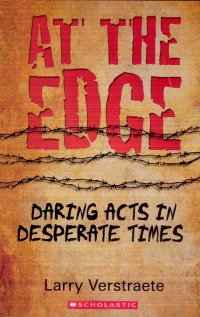| ________________
CM . . .
. Volume XVI Number 32. . . .April 23, 2010
excerpt:
The excerpt from the Introduction to At the Edge sets the stage for the following chapters of harrowing situations and heroic actions. The book consists of four chapters and an epilogue. The chapters, At the Edge of Disaster, At the Edge of Terror, At the Edge of Injustice, and At the Edge of the Impossible, are each divided into five to seven stories. The topics range from Jewish prisoners in Birkenau Death Camp, Hurricane Katrina, a rescue on Mt Everest, Chernobyl, a kidnapping, the massacre in Rwanda, Flight 92 on September 11, 2001, and Terry Fox’s Marathon of Hope. Each story is succinctly written – three or four pages. They include stories of heroes such as the railway dispatcher in 1917 who warned incoming trains that ships in Halifax harbour were exploding. He stayed at his post and lost his life in order to send the message. “Counterstrike” is the story of Lieutenant Colonel Stanislov Petrov who, in 1983, disobeyed protocol when his computer console warned that it appeared that nuclear missiles had been fired from the US and were headed for Moscow. He knew that the warning system sometimes malfunctioned and gave false alarms. He did not push the red button to launch a counter attack which could have started WWIII. Unfortunately, instead of Petrov’s “being commended for his bravery and quick thinking, authorities hushed the incident to keep it secret” until recently. At the Edge is a versatile and compelling read. Many of the stories took place in Canada. Others came from around the world making it appealing to a wide range of readers. Subtitles within each chapter, such as “Just in Case;” “To the Left, Death,” “Fear in Room 7” and “Leap of Faith” will pique interest. Although the book has no colour inside, it has enough variety in its design and typeface to make it attractive. Lines of barbed wire highlight short introductions to each story. For instance, “The polar bear ripped apart the tent and mauled the campers inside. Armed with only a pocket knife, what chance did Eric Fortier have?” entices readers to peruse the story of the attack in Nunavut. Additional visual variety comes from the black and white photographs liberally sprinkled throughout – often two per story -- and different typefaces. There are also a number of suitable quotes that break up the text of the stories. They may reflect the theme of the story. For example, at the beginning of Chapter 1 “At the Edge of Disaster” is a Japanese proverb: “The reputation of a thousand years may be determined by the conduct of one hour” refers to the instantaneous, and sometimes life-threatening, decisions people have to make. Others are quotes in the survivors’ own words. Petrov, mentioned above, stated, “I just believed in my judgment and I trusted those around me.” Furthermore, there are page-long newspaper type articles labeled CALL TO ACTION. The October 3, 1986/North Atlantic Ocean article, for instance, tells of an explosion aboard a Soviet nuclear submarine and the brave seaman who lost his life fixing a jammed operating mechanism. He not only saved his crewmates, but he stopped the radioactive elements from poisoning the ocean and atmosphere. Those readers interested in other extraordinary tales of heroes may refer to the very useful “Further Reading”. An Acknowledgements page and Photo Credits complete the title. Larry Verstraete combines his talent for writing with his training as a science teacher. Although many of his books, such as Whose Bright Idea Was It?, Extreme Science and Accidental Discoveries, are on scientific topics, several others are not. The latter group includes G is for Golden Boy: A Manitoba Alphabet and Survivors! True Death Defying Escapes. In a CM Magazine Profile, Verstraete states: “To many people, nonfiction is one thing – dry facts. But those facts can be presented in many different ways and that leads to a great variety of approaches and creative opportunities.” As he states above, Verstraete takes readers beyond the dry facts of historical events and gives them a human focus. This interview continues with his comment on reading for boys, “Give them something short, fast, dramatic or an odd-ball story perhaps, allow them to dip into the book at any entry point, and the facts come out of that as a secondary feature.” He accomplishes both claims – in spades! Each story can stand alone so readers can dip into the book at any point. One thing is for sure though; once started, the book will be hard to put down. My only negative remark, and it is certainly a small one, is that the Table of Contents does not list each story by title. Overall, At the Edge will be a very worthwhile purchase; it will certainly grab and sustain the attention of many readers. Highly Recommended. Marilynne V. Black is a former B.C. elementary teacher librarian who completed her Master of Arts in Children’s Literature (UBC) in the spring of 2005. She is now working as an independent children's literature consultant with a web site at www.heartofthestory.ca.
To comment
on this title or this review, send mail to cm@umanitoba.ca.
Copyright © the Manitoba Library Association. Reproduction for personal
use is permitted only if this copyright notice is maintained. Any
other reproduction is prohibited without permission.
NEXT REVIEW |
TABLE OF CONTENTS FOR THIS ISSUE
- April 23, 2010.
AUTHORS |
TITLES |
MEDIA REVIEWS |
PROFILES |
BACK ISSUES |
SEARCH |
CMARCHIVE |
HOME |
